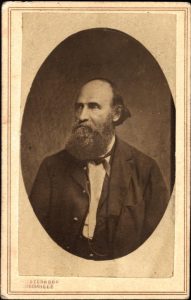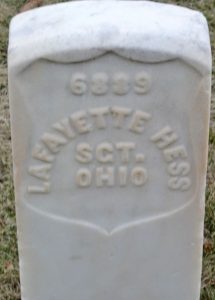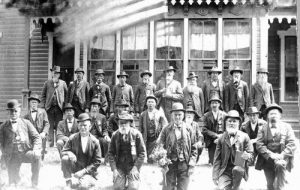“At Liberty Gap . . . Every Man is a Hero”: The Story of an Ohio Soldier
While I have spent many years collecting Civil War artifacts and photographs, at some point I made a conscious decision to limit the scope of my collection to only those items from a specific geographic area, namely southeastern Ohio and the northern panhandle of West Virginia. I have managed to collect dozens of photographs, letters, and other artifacts from several of the area’s hardest fighting regiments, including the 15th, 52nd, and 98th Ohio Infantry regiments. Once word gets out that you collect Civil War, the material often seems to find you.
That’s just what happened several years ago when I received a call that a set of wooden crutches had been discovered in a house slated for demolition in nearby Belmont County, Ohio. They were in remarkable condition, with octagonal shafts and attractive brass keepers on the bottom. As an added bonus, they were just my size, in the event I needed to use them after telling my wife I was bringing home a set of antique crutches.

What was most unique about the set was the handsome block letters carefully carved into each crutch, the first reading “Marquis de Lafayette Hess,” and the second reading “M.D.L.F. Hess, Co. F 15th Regt. O.V.I.” These crutches are a visceral connection to not only a forgotten local soldier with an outstanding name, but the forgotten battle that necessitated their use. Naturally, I had to have them.
As evidenced by his name, Marquis de Lafayette Hess was born into a patriotic family in Washington Township, Belmont County, Ohio. Hess’s father, Jeremiah Hess, was born in Pennsylvania in 1775 and served in the War of 1812 before moving west to Ohio. By 1860, Lafayette was living with his older brother, George Washington Hess, and his sons James Monroe and Cassius Marcellus, the family working a farm in the neighborhood of Armstrong’s Mills along bucolic Captina Creek.
The outbreak of civil war was a significant concern for Belmont County farmers like the Hess family. A primarily agrarian county, for decades Belmont farmers had utilized the Ohio River to ship crops and goods to markets as far as New Orleans. As such, business interests in Belmont were more closely aligned to the south and west than to the north and east. Located immediately adjacent to the northern panhandle of Virginia, there was a preponderance of Virginia script in circulation in Belmont County. One Belmont County resident wrote of a near panic in the county in 1861 following Virginia’s secession, noting that “money is spent by the market folks as soon as they get it fearing that it may become worthless on their bonds.”[1] As such, antiwar sentiment remained strong in Belmont County throughout the war, with the county seat home to the St. Clairsville Gazette, one of the most outspoken Copperhead newspapers in the state.
In the 1860 presidential election Abraham Lincoln lost Belmont County by more than 1,200 votes. Lafayette Hess bucked this trend and instead became an active Republication, serving as a delegate to the county’s “Unconditional Union Convention” in August 1861.[2] The following month he enlisted as a corporal in Company F of the 15th Ohio Volunteer Infantry, a recently returned 90-day regiment that was reorganizing for a three year enlistment. The regiment would winter in Kentucky before seeing hard fighting at Shiloh and Corinth.
In late December 1862 the 15th Ohio moved south as part of Gen. William S. Rosecrans’s advance on Murfreesboro. Situated on the extreme right of the Federal army at the battle of Stones River on December 31, 1862, the 15th Ohio was hit in a crushing attack by two divisions of Confederate Gen. William J. Hardee’s Second Corps. Alexis Cope, regimental historian for the 15th Ohio, recalled “our men began to fall and after delivering one volley, seeing the enemy in close proximity, three lines deep, with no supports near us, we were ordered to fall back. A high rail fence was close in our rear…this fence proved to be a fatal obstruction to anything like an orderly retreat. It was in this field and at or nearby this fence that we suffered our chief losses of the four day’s battle.”[3]
The 15th Ohio suffered grievous losses at Stones River, including 19 men killed, 80 wounded, and more than 100 captured, Lafayette Hess among the latter. Hess and his comrades were transferred to Libby Prison in Richmond in January 1863, remaining in captivity for more than a month before being exchanged at City Point. From there the men returned home before returning to the regiment in early June 1863, just in time for one of the most significant, if unheralded, campaigns of the war.
The hallmark of General Rosecrans’s Tullahoma campaign was the skillful maneuvering of four Federal infantry corps, utilizing multiple road networks and feints to confuse the location of the decisive thrust south towards Chattanooga. The 15th Ohio moved out of Murfreesboro on June 24 as one such feint, due south towards Liberty Gap, one of three vital passes through the Highland Rim. While Lee White capably covers the Battle of Liberty Gap elsewhere in this volume, it’s worth examining the 15th Ohio’s contributions at this engagement.
Arriving at Liberty Gap on the afternoon of June 24 and finding the pass lightly guarded by two Arkansas infantry regiments, the Ohioans were deployed as skirmishers, pressing the right flank of the 5th Arkansas. Lieutenant Colonel Frank Askew of the 15th Ohio wrote “the whole line moved forward across the open field and up the steep face of the hill at a double-quick pace.”[4] In a driving rain the Confederates stubbornly contested the pass before ultimately withdrawing one mile to the south, intent on further delaying the assumed main Federal thrust.

The following morning, as scattered skirmishing echoed along the hillsides of Liberty Gap, the Confederate commander, Brig. Gen. St. John R. Liddell, mistakenly believed the Federal troops were withdrawing. Sensing an opportunity, Liddell threw his Arkansas regiments against them , renewing the battle of the day prior. The 15th Ohio had been held in reserve through the morning, but by 3:00 p.m. were called into the fight to support the 32nd Indiana. Askew’s report of the battle noted that the regiment “encountered a very spirited attack…designed to drive us from the summit of the hill,” which the Buckeyes “gallantly met and repulsed,” driving the Confederates across the valley and to the hill beyond. From their vantage point, the 15th likely witnessed their sister regiment in Willich’s Brigade, the 49th Ohio, utilize advance firing to beat back another Confederate attack.[5] A tactical innovation imparted by their brigade commander, August Willich, the advance firing maneuver entailed a battle line of four ranks, each rank advancing alternately and firing while the others stopped to load. The “rolling wall of continuous fire” proved too much for the Confederates, who continued to pull south, leaving Liberty Gap to the Federals.[6]
Reports of the battle and the regiment’s involvement were glowing. Willich noted that “the highest ambition of a commander must be satisfied by being associated with such men,” while division commander Brig. Gen. Richard W. Johnson believed that “the affair at Liberty Gap will always be considered a skirmish, but few skirmishes ever equaled it in severity.”[7] In his report of the battle, Lieut. Col. Askew recalled Liberty Gap as “where every one did his duty fearlessly and faithfully, where every order was obeyed with alacrity and enthusiasm, where men advanced under such showers of death dealing missiles upon an enemy posted with all the advantages which our adversaries had.”[8]
Company F accounted for 8 of the 32 casualties suffered by the 15th Ohio during the battle of Liberty Gap, the regiment sustaining more than a third of the casualties in the entire first brigade. Among the wounded in the fighting on June 25 was Lafayette Hess, only recently returned to the regiment following his capture and confinement. Hess suffered a painful lower leg wound, described by his company captain, Amos Glover, as severe, but not mortal. Once again, Hess was sent home on leave to recuperate. It was during this time that Hess used these crutches.
Hess would remain home through the remainder of 1863. In his absence the 15th Ohio was engaged at Chickamauga, Chattanooga, and Missionary Ridge, before they themselves returned to Ohio on a veteran’s furlough. The regiment regrouped at Columbus, Ohio on March 18, 1864, poised to return to the front. Lafayette Hess returned with the regiment, rested and healed from his Liberty Gap wound. Hess also returned as a married man, having wed Lydia Ann McFarland of Belmont County exactly one month earlier. In April 1864, he was promoted to the rank of sergeant, a testament to the esteem in which he was held despite two extended absences from the regiment following his capture and wounding.
As part of Maj. Gen. O.O. Howard’s IV Corps, Army of the Cumberland, the 15th Ohio would be engaged throughout the Atlanta Campaign, notably at Rocky Face Ridge, Resaca, and Pickett’s Mill. At Kennesaw Mountain, the regiment was positioned near the center of the Federal line. On June 21, General Howard ordered the 15th Ohio to attack and hold Bald Knob opposite the Federal line, mistakenly believing he was issuing orders to an entire brigade rather than a single regiment. The 15th Ohio surged ahead “as resolute as Pickett’s charge…as unique as Jackson’s onset at Chancellorsville,” capturing the Confederate works on Bald Knob and taking several dozen prisoners.[9] The engagement cost the regiment 55 casualties, General Howard remarking that “no adventure has ever thrilled me like that spirited charge of the Fifteenth Ohio.”[10]

The regimental historian for the 15th Ohio recalled that picket duty on Bald Knob was “more than usually hazardous,” the men on duty day and night through constant firing along the line. On June 23, the regiment was advanced from their line as skirmishers in support of skirmishers from Brig. Gen. William B. Hazen’s brigade. The advance was mismanaged and Hazen’s men failed to move forward, exposing the 15th Ohio to a devastating enfilade fire. The regiment lost sixteen men killed and wounded in the fighting on June 23. It was here at Bald Knob that Lafayette Hess, having survived his capture at Stones River, confinement at Libby Prison, and wounding at Liberty Gap, breathed his last.
We don’t have an account of Hess’s death. We don’t have his letters or diaries, or even a photograph. He left no children. In 1865 his widow received a pension of $8.00 per month and would later remarry to a veteran of the 176th Ohio. In 1886, veterans from Hess’s neighborhood of Armstrong’s Mills formed the Lafayette Hess Grand Army of the Republic Post in his honor.

The sheer scope of the Civil War is so vast that it can be easy for the individual soldiers to become faceless. There is no doubt that were it not for these crutches that survived more than a century and a half tucked away inside a dilapidated home, Lafayette Hess would remain one of the hundreds of thousands of seemingly faceless casualties of the Civil War—a casualty of a battle and a campaign too often overlooked in Civil War historiography. When asked to cite instances of personal courage or heroism in his regiment during the fighting at Liberty Gap, Lt. Col. Frank Askew refused, believing that in struggles such as the regiment endured at Liberty Gap, “every man is a hero.”[11] These crutches are seemingly our only surviving visceral connection to one such hero who sacrificed his body at Liberty Gap and his life at Bald Knob.
————
[1] Caleb H. Cope to Alexis Cope, 6 June 1861, Cope Family Papers, Historical Society of Mount Pleasant, Ohio (HSMP).
[2] Belmont Chronicle, 8 August 1861.
[3] Alexis Cope, The Fifteenth Ohio Volunteer and Its Campaigns, 1861 – 1865 (Published by the Author, 1916), 235 – 236.
[4] Cope, The Fifteenth Ohio, 288.
[5] Ibid.
[6] David A. Powell and Eric J. Wittenberg, Tullahoma: The Forgotten Campaign that Changed the Course of the Civil War, June 23 – July 4, 1863 (Savas Beatie, 2020), 156.
[7] Cope, The Fifteenth Ohio, 291 – 292.
[8] Belmont Chronicle, 6 August 1863.
[9] Cope, The Fifteenth Ohio, 498-499.
[10] Ibid, 500.
[11] Belmont Chronicle, 6 August 1863.
I am so glad that someone had the presence of mind to let you know about these crutches. Thank you for telling us the story of Sgt. Hess. He is no longer a forgotten soldier, great story.
Thank you for providing a “face” to one of countless “faceless” soldiers who comprise the units engaged in tactical operations. Occasionally we read about heroes like Rufus Dawes ofthe Iron Brigade, but for the most part, my readings fail to illuminate the individual personalities of the many combatants.
This is a really excellent article, and I appreciate your sharing Hess’s interesting and tragic story! I wondered if you’ve visited Liberty Gap and, if so, I’m curious if it’s an visitable and interpreted site?
Hi George,
Thanks so much. I haven’t been to Liberty Gap, and as I understand the battlefield remains undeveloped private property with no public access.
Thank-you for this moving article. The crutches add a vivid element.